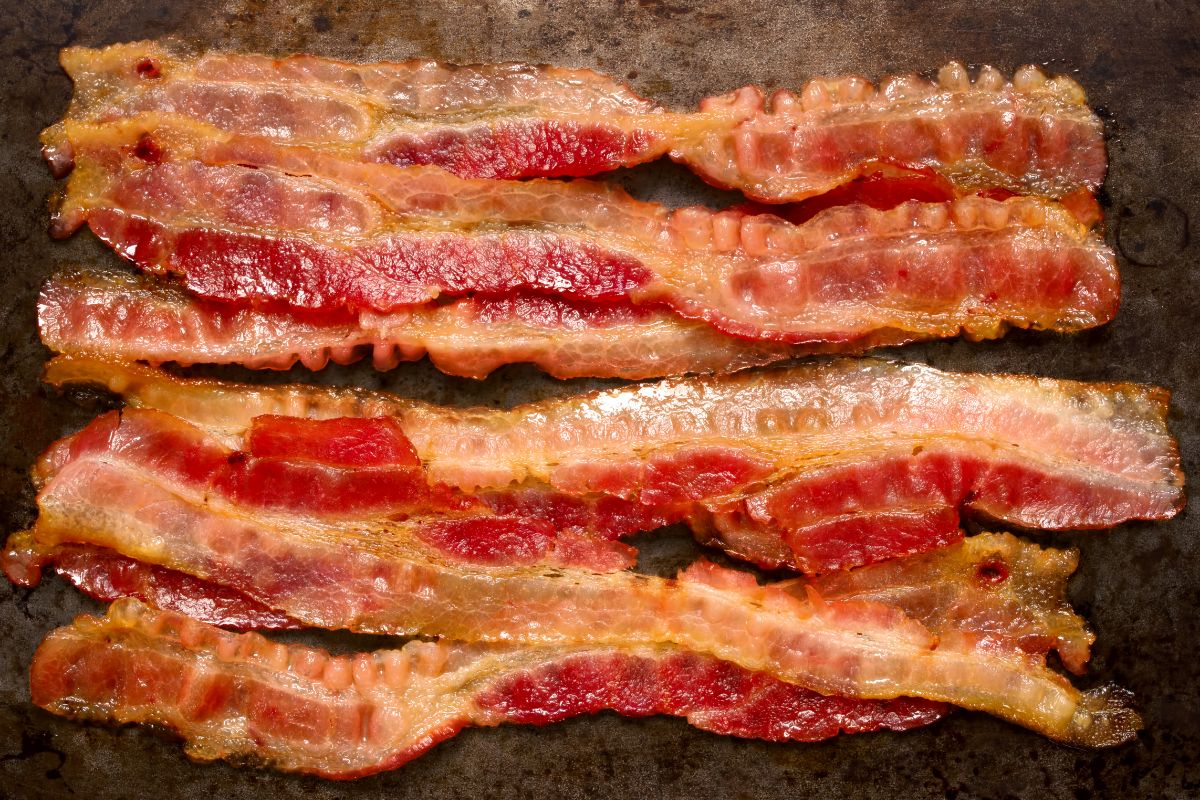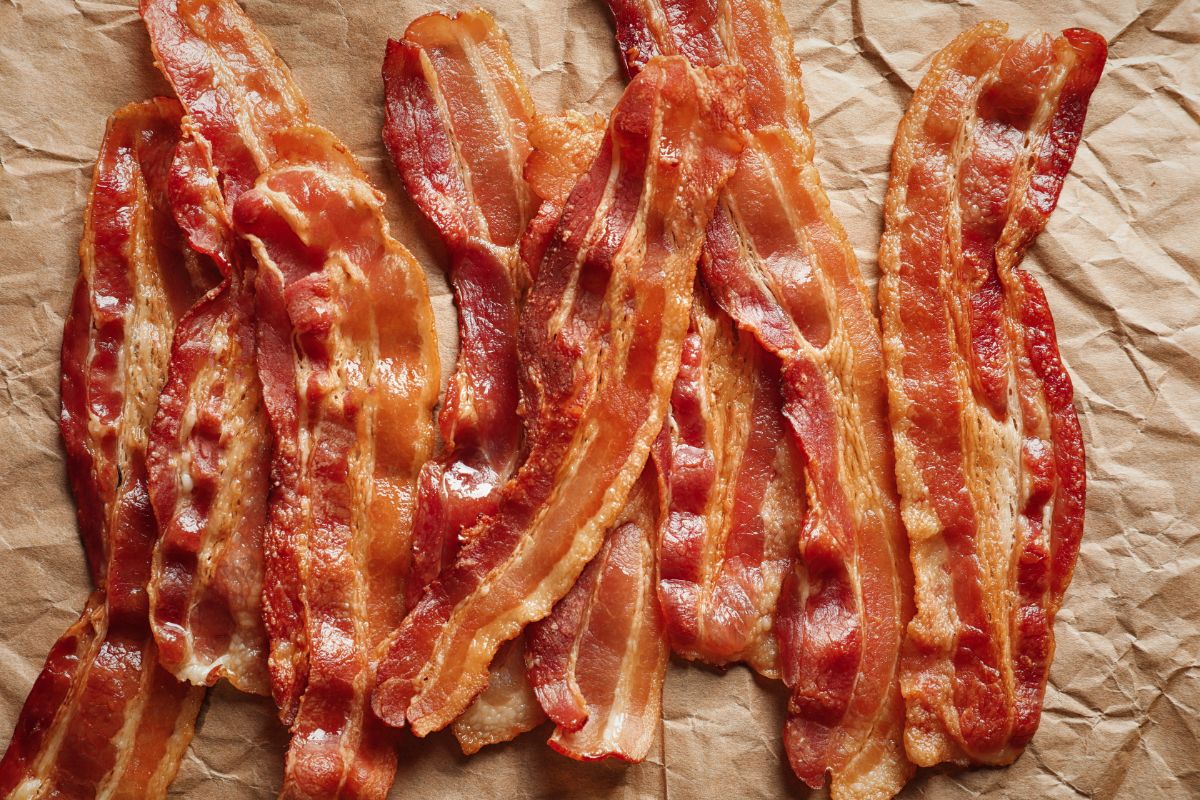Are you looking to cook bacon in your oven? Are you fed up with hot grease spitting at you and looking for an alternative? Or are you curious about cooking your bacon in the oven and want to know more?

No matter the question that brought you here, we have the answers for you!
Finding the best way to cook bacon can be tricky, especially if you don’t cook it often.
You head online for some guidance but are met with pages and pages of confusing and conflicting advice. You see people mention the oven cooking your bacon, but there isn’t enough information for you.
Frustrated and disappointed, you are left unsure of what to do next. Do you try to cook bacon in the oven and have a disaster? Or do you select a different meat to eat?
Well, that’s where we come swooping in to save the day! Keep reading to see the ultimate guide to perfect bacon. Today, we are showing you how to cook bacon in the oven and everything you need to consider when cooking bacon in the oven.
When Should I Cook Bacon On The Stove?
The oven is arguably the best place to cook your bacon. But there are times when the stove is your better choice. How do you know when the best time to cook bacon on the stove is? We’ve got all the times when it’s best to cook bacon on the stove outlined below.
- If the recipe you are using calls for bacon to be cooked in a wok.
- If you don’t want to add heat to your kitchen in the oven. It’s worth noting that you might get sweaty cooking your bacon on the stove too!
- When you only need a small amount of bacon (3 or fewer pieces).
What Are The Benefits Of Cooking Bacon In The Oven?
There are many benefits to cooking your bacon in the oven. Not only will you get delicious bacon, but some of these perks will make you want to throw your skillet out! Let’s look at our top benefits for cooking bacon in the oven now.
- Hands-off cooking method
- You can cook crispy or chewy bacon
- The bacon cooks more evenly
- It’s easy to clean up
- It’s a quicker way to cook all your bacon
Will Bacon Grease Splatter In The Oven?
No! This might come as a surprise to you, but bacon does not splatter when you cook it in an oven. It can be cooked on a rimmed baking sheet pan or lined with some aluminum foil.
You can even cook your bacon on top of an oven-safe rack on a baking sheet! Cooking it this way, your excess grease will simply drip to the bottom of the pan, leaving your bacon to cook without any grease splatters!
Cooking Bacon In The Oven: An Experiment
To see how bacon is cooked in the oven, we thought it was best to experiment! We cook our bacon in the oven all the time but are always keen to try out new variations. So we took some regular bacon, thick-cut bacon, and thinner pieces, turned our oven on, and got cooking!
Keep reading to see what variables we tested when oven-cooking our bacon and what our results were.
What We Tested
We tested the following variables.
- Cooking temperatures 0 350, 375, and 400 degrees Fahrenheit and broiling at 400 degrees Fahrenheit
- Bacon temperature – room temperature bacon vs bacon straight from the refrigerator
- Turning – leaving the bacon on the same side for the entire time or flipping halfway through
- Pan or wire rack – cooking the bacon on a wire rack on top of a baking sheet vs. directly on the pan
- Covered or uncovered – covering bacon with aluminum foil, parchment paper, or another wire rack vs. cooking the bacon uncovered
- Pan lining – no lining vs. lining the pan with aluminum foil
- Preheated or cold oven – preheating the oven beforehand vs. putting the bacon in a cold oven
We tried to experiment with as many of these variables as possible to thoroughly test each option to see what was the best way to cook bacon in the oven!
Cooking Bacon In The Oven: Our Results
After cooking the bacon in the oven using a mixture of all the variables we mentioned, here is what we found out! Two techniques impacted the oven-cooked bacon, these were whether the bacon is cooked on a pan or a wire rack and if the bacon was flipped while cooking or not.
Which were the better options? Don’t worry, we have a detailed breakdown of the results coming up now!
Should I Cook Bacon On A Wire Rack Or A Rimmed Pan?
How you cook your bacon will determine the final result. Use the table below to see how cooking bacon on a wire rack or directly on the pan impacts the final results.
| Bacon cooked on a wire rack | Bacon cooked directly on a pan | |
| Texture | chewy | crispy |
| Cooking time | Increased by 3-7 minutes | Decreased by 3-7 minutes |
| Did it shrink? | Not overly | Noticeably shrunk |
| How did it cook? | straight | Curled during cooking |
When deciding whether you want to cook your bacon on a wire rack or a baking sheet, consider whether you want your bacon to be crispy or chewy, if you are happy with the different cooking times, the level of shrinkage, and whether your bacon is straight or curled.
Wire Rack
If you like your bacon to be slightly chewy, then cooking your bacon on an oven-safe cooling rack on top of a baking sheet is the perfect option for you. Doing so gives perfectly chewy bacon that doesn’t shrink and stays straight!
Depending on the thickness of your bacon and the temperature you set the oven to though, it might take longer for your bacon to cook. On average, we found this method took 3 to 7 minutes longer for our bacon to cook.
Rimmed Baking Sheet
If you want crispy bacon, then you should cook it directly on the baking sheet. The bacon will cook in its own grease, allowing it to crisp up and become perfectly crispy every time!
Cooking bacon directly on the baking sheet gives you crispy bacon that curls more and does shrink. However, it will cook quicker! On average, we found that bacon cooked directly on the sheet cooked 3 to 7 minutes faster than on a wire rack.
Do I Flip Oven Cooked Bacon?

If you care about your bacon being straight or crooked, then you will want to flip your bacon! Flipping your bacon halfway through cooking helps to keep it straight.
Flipping your bacon halfway through cooking also helped prevent it from sticking to the rack once it had finished cooking!
If you plan to flip your baking while cooking, it’s best to do it just past the halfway mark when cooking it.
What are the results of flipping bacon part way through cooking? Let’s take a look now.
- Flipped bacon cooked on a rack did not stick to the rack. Unflipped bacon stuck to a cooler rack, especially when it was left to cool.
- Flipped bacon cooked straighter, but it did shrink more than unflipped bacon.
It’s incredibly frustrating when bacon sticks to the pan, but there are ways you can prevent it! We recommend removing the bacon from the rack as soon as the rack comes from the oven.
You can also spray the rack before cooking the bacon, although this isn’t ideal, as there is already a lot of grease and fat in the bacon.
What To Consider When Oven Cooking Bacon
There are a few factors to consider when cooking bacon in the oven. Let’s take a look at these factors now to help you learn more about the best way to cook bacon in the oven.
Temperature
Changing the temperature does not change the final result of oven-cooked bacon. However, it does impact how long it takes for bacon to cook!
Cooking your bacon at 375 degrees Fahrenheit takes 20 to 25 minutes. This is our favorite temperature to cook bacon and achieves the best results!
Our least favorite was broiling the bacon. You need to keep an eye on bacon when using the broiler to ensure it doesn’t burn.
You also need to flip them halfway through cooking to ensure that the bacon cooks evenly. If you don’t think about the bacon too much while it is cooking, then the broiler isn’t for you!
We have some guidelines below for the different cooking temperatures for bacon and how long it will take to cook!
| Cooking Temperature | Bacon Placement | Cooking Time |
| 350 degrees Fahrenheit | On a wire rack | 22 – 25 minutes |
| 350 degrees Fahrenheit | On a pan | 20 – 24 minutes |
| 375 degrees Fahrenheit | On a wire rack | 20 – 23 minutes |
| 375 degrees Fahrenheit | On a pan | 15 – 20 minutes |
| 400 degrees Fahrenheit | On a wire rack | 17 – 23 minutes |
| 400 degrees Fahrenheit | On a pan | 12 – 17 minutes |
| Broil at 400 degrees Fahrenheit | On a pan | 5 – 7 minutes (flipping after 3 – 4 minutes) |
How To Temper Bacon
Another thing to consider when cooking bacon in the oven is whether to temper your bacon or not. Tempering bacon is when you bring your bacon to room temperature before you cook it.
As bacon is usually thin, you don’t need to worry too much about it cooking evenly. But what happens when you temper it? Well, it cooks about one or two minutes faster than bacon that is cooked straight out of the refrigerator.
For best results, we recommend removing your bacon from the refrigerator and then turning on the oven. Once the oven is heated, the bacon should be tempered enough to cook a little quicker!
Using A Baking Sheet With Crumpled Foil
If you don’t own a wire rack and want chewy bacon, you can use crumpled foil on a baking sheet. Lay your bacon on the foil in a single layer to achieve chewy bacon!
This method ensures the bacon is cooked out of the grease, but it isn’t the smoothest process. Your bacon can be difficult to flip and will stick to the foil. Where possible, it’s best to use a wire rack to cook chewy bacon!
Cooking Bacon In The Oven: What You Need
To cook your bacon in the oven, you will need the following:
- Large baking sheet pan with rimmed sides
- Raw bacon (any brand or thickness)
You can also use any of the following, although these are optional items that you don’t necessarily need.
- Tongs
- Wire rack that fits your baking sheet pan
- Parchment paper or aluminum foil
Cooking Tips
To help you oven cook your bacon like a pro, we have a few tips you can make use of. Let’s take a quick look at them now.
- Cooking your bacon directly on the bacon sheet will leave you with a big mess to clean up
- It’s best to line your pan with aluminum foil to save time cleaning up. You can use parchment paper but it doesn’t fully contain the grease, leaving you with some cleanup afterward.
- Use a rimmed baking sheet with sides to stop any grease from escaping the pan!
- If your oven has hot spots, rotate your sheet during cooking to ensure the bacon cooks evenly.
- When using foil, fold it over all sides of the pan. This stops the grease from leaking onto the baking sheet.
- To clean up, fold the foil inwards. This traps the oil, preventing it from tipping onto your baking sheet.
How To Cook Bacon In The Oven
Let’s get into what brought you here today and see how to cook bacon in the oven! When cooking bacon in the oven, consider how you want your bacon.
Use the tips and suggestions we gave you earlier to decide whether chewy or crispy bacon is for you and if you will cook it on a wire rack or pan, and if you will flip it halfway through cooking or not.
Once you have made these decisions and got your bacon and cooking tools, it is time to get cooking! Use our steps below to see how you can cook bacon in the oven!
- Preheat: Start by removing your bacon from the refrigerator and preheating your oven. We recommend setting your oven to 190 degrees Fahrenheit.
- Prep Your Tray: Next, choose a rimmed baking sheet and line with aluminum foil. If you are cooking chewy bacon, place a wire rack on top of the baking sheet.
- Add Your Bacon:Now it’s time to add your bacon! Place the strips in a single layer on your wire rack or pan. Don’t worry if the strips touch slightly, as they will shrink when you cook them. Make sure that none of your bacon strips overlap though, as this will cause them to cook unevenly.
- Cook Your Bacon: Once the oven has preheated, add your tray to the oven! Ideally, put your tray in the middle of your oven, avoiding any cold spots. Cook your bacon for 15 to 20 minutes if it is cooking in the pan. Allow 20 to 25 minutes if your bacon is on a wire rack.
- Flip Your Bacon: If you want straight bacon that doesn’t get stuck to your wire rack, flip your bacon halfway through the cooking time. Ensure that you turn each strip of bacon over and that none are overlapping as you flip them, so they continue to cook evenly.
- Remove Bacon: Once your bacon is cooked, remove it from the oven. Carefully remove it from the pan and add it to a plate lined with paper towels. This will drain any excess grease from the bacon before you eat it.
- Serve Your Bacon: Serve while it is hot! Add it to your breakfast, sandwich, or any meal you are making and enjoy!
How To Cook Crispy Bacon
For steps on cooking crispy bacon only, you can follow these steps below.
- Remove your bacon from the refrigerator.
- Preheat your oven to 375 degrees Fahrenheit. Place an oven rack in the center of the oven.
- Line a rimmed baking sheet with aluminum foil. Fold the foil over the sides to ensure grease does not escape.
- Place your bacon on the foil without any of the slices overlapping.
- Bakie for 15 to 25 minutes depending on how thick your bacon is.
- You can flip the bacon at 10 minutes if you want to
- Drain the bacon on a plate lined with paper towels.
How To Cook Chewy Bacon
To see how to cook chewy bacon only, you can follow our steps below.
- Remove the bacon from your refrigerator.
- Preheat the oven to 275 degrees Fahrenheit and place a wire rack in the center of the oven.
- Line your rimmed baking sheet with foil, folding it over the sides to prevent grease from leaking.
- Place a metal baking rack over the covered pan.
- Place your bacon strips on the wire rack without any overlapping.
- Place the pan into the oven and cook for ten minutes.
- Remove the tray and flip each piece of bacon using tongs.
- Return to the oven for another 8 to 12 minutes depending on the thickness of your bacon.
- Drain your bacon on a plate lined with paper towels.
How To Store Leftover Bacon
On the rare occasion that you have bacon leftover, you might be wondering what the best way to store it is? Well, it is best stored in an airtight container. You should wait for your bacon to cool completely before adding to an airtight container and storing in your refrigerator.
Your leftover bacon will last for four to five days this way. After this point, you should discard your bacon if you have not eaten it.
To reheat your bacon and enjoy hot, warm each slice in your microwave. This should take 10 to 15 seconds. If you are adding your bacon to a sauce, you can add it in directly without needing to warm it through.
What Is The Best Temperature To Cook Bacon In The Oven?
To help you decide what temperature to cook your bacon for, we have included the typical oven temperatures used to cook bacon below. We also have how long your bacon will take to cook with each temperature too!
- 400 degrees Fahrenheit directly on a pan for 12 to 17 minutes
- 400 degrees Fahrenheit on a rack for 17 to 23 minutes
- 375 degrees Fahrenheit directly on a pan for 15 to 20 minutes
- 375 degrees Fahrenheit on a rack for 20 to 23 minutes
- 350 degrees Fahrenheit directly on a pan for 20 to 24 minutes
- 350 degrees Farenheit on a rack for 22 to 25 minutes
Use these temperatures to help you find the perfect one (and time) to cook your bacon in the oven.
Frequently Asked Questions
Before you leave us, be sure to check out our brief FAQ section to get the answers to your last minute questions!
To make crispy bacon in the oven, follow our steps below.
1. Line a rimmed baking sheet pan with aluminum foil.
2. Lay your bacon on top of the foil in straight lines, ensuring that the bacon pieces do not overlap or touch one another.
3. Cook the bacon in the oven. As your bacon cooks in its own grease, it will become crispy!
To avoid a mess in the oven when cooking bacon, you should line the pan with aluminum foil.
When covering the pan, ensure that the foil rises over the pan edges before you fold down the foil. This stops the grease from spilling in the oven, leaving you with a mess that would need to be cleaned up.
Once your bacon is cooked, you can remove the pan from the oven. You should transfer your bacon to a plate. Cover the plate with paper towels. These will help to drain any excess grease from the bacon before you eat it.
Carefully remove the foil from the tray. You might find it easier to do this once the tray has cooled to room temperature. If you have covered the pan carefully, there will be no grease left on the pan, saving you the need to clean it up!
The foil can then be discarded. Remember, do not tip any of the hot grease from the bacon down your drains. It is best to dispose of the foil and grease together in your bin.
Alternatively, you can catch and store your leftover grease. Leftover bacon grease can be used to flavor baked beans, saute veggies, fry eggs, or anything else that you need to cook!
Yes, you can cook bacon in the oven without foil! You can swap your foil for parchment paper if you don’t have any foil to hand to protect your tray. You also don’t need to line your baking sheet with anything if you don’t want to.
However, if you do not line your baking sheet or pan with anything, the grease from your bacon will be collected here.
This will make it harder to clean up after cooking, especially if your bacon was extra-greasy! To save yourself time and energy, it’s better to cover your pan before you cook your bacon.
Yes, you can cook bacon in the oven using parchment paper. However, parchment paper does have some drawbacks. It does not fold and stay in place like aluminum foil does. This means that parchment paper won’t keep the bacon fat and grease in place like foil does.
This means that some grease can escape from the parchment paper, especially when you remove it from the pan.
This will leave you with grease that needs to be cleaned up. Sure, it won’t be as much as if you didn’t line the tray, but where possible, we think it’s best to use aluminum foil!
If you don’t have a wire rack, you can place your bacon on a rimmed pan that has been lined with aluminum foil. Your bacon will then cook in its own grease, leaving you with crispy bacon to enjoy!
We do recommend flipping your bacon halfway through cooking to ensure that it does not stick to the foil or curl as it cooks.
To cook bacon in the oven with brown sugar, it is best to use thick-cut bacon. Place your bacon strips on a wire rack or directly onto the pan. Sprinkle them with brown sugar before placing them in the oven.
Cook your bacon for 20 to 25 minutes. We recommend flipping your bacon halfway through cooking time too, although this is an optional step. Once your bacon has finished cooking it can be placed on plates lined with paper towels.
This will absorb any hot grease quickly before you transfer it to a clean plate to cool.
Make sure you don’t leave it on the plate with paper towels for too long, as the brown sugar will stick to the paper towels! Instead, you want to dab away the grease quickly before allowing your bacon to cool.
Cooking your bacon with some brown sugar will add a sweetness to the meat that is delicious! We recommend trying it, especially if you have some thick-cut bacon to use up.
Final Thoughts
And there you have it, the perfect way to cook bacon in the oven! There are lots of different factors to consider when cooking bacon in the oven, but with our method today, we are sure you can find the perfect way to cook your bacon!
Whether you enjoy it crispy or chewy, the oven is the best place to cook large quantities of bacon. Plus, you can avoid the grease splatter when you cook bacon in the oven, what more could you ask for? The oven is a convenient and easy way to cook your bacon that will deliver you perfect results every time.
Why not give it a try today and use the method we gave you earlier?
- How To Reheat A Cheesesteak - November 5, 2023
- What Are Three Must Have Kitchen Knives? - September 22, 2023
- How To Protect Edges Of Pie Crust - June 15, 2023








